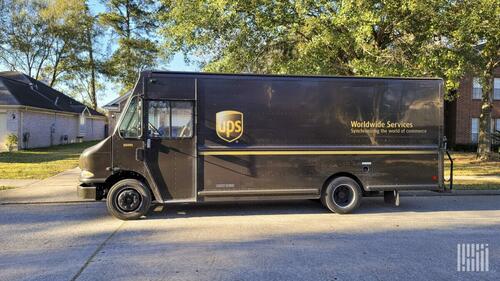UPS Suffered Larger-Than-Expected Shipment Losses Due To Labor Concerns
By Mark Solomon of Freight Waves,
UPS said it experienced greater-than-expected shipment losses due to concerns about a possible Teamsters union work stoppage, with about 1 million daily packages being diverted to competitors and 200,000 additional daily parcels not entering the system because sales fell through due to shipper uncertainty.
Carol B. Tomé, UPS CEO, told analysts Tuesday that she expects by year’s end to win back all of the business and to close deals on lost sales, though the company’s efforts will take some time. “It’s all hands on deck” to recover diverted volumes and push about $7 billion in potential sales through the pipeline, she said. “We are already seeing some volume return,” she said, without elaborating.
UPS has set up a “control tower” operation whose mission is to win back business without it leading to service disruptions, Tomé said.
Average daily volume in UPS’ domestic segment, its largest, dropped 9.9% in the second quarter, compared to the 2022 period. There was more parcel diversion in July than the company expected, though the losses weren’t as severe as in June. UPS said it expects that by the end of 2023 it will return average daily volumes to even with December 2022 levels. For the second half of 2023, it expects average daily volumes to be down by single-digit percentages year over year.
According to the company, the diverted business was split evenly, with one-third each going to FedEx Corp. (NYSE: FDX), the U.S. Postal Service and regional delivery carriers.
UPS’ U.S. average daily volume in the quarter totaled 17.4 million parcels, according to ShipMatrix, a consultancy. Domestic and international volume combined totaled 20.9 million daily parcels, the firm said.
The company expects wages and benefits to rise by 3.3%, compounded annually, over the life of the contract. The bulk of the increases will occur in the first year, because the Teamsters wanted a front-loaded bump to offset current inflation levels, UPS said. The first-year increases, which will average $2.75 an hour for full- and part-timers, were higher than planned, UPS said. The fifth year will be the second-highest-cost year, with smaller increases in years two through four.
Tomé would not specify what level of general rate increase will be imposed for 2024 to recoup the higher labor costs.
A tentative five-year agreement was reached July 25, heading off a potential Aug. 1 strike. The 340,000 UPS Teamsters have until Aug. 22 to ratify or reject the agreement. Officials representing 162 UPS Teamster locals have unanimously endorsed the contract.
Amit Mehrotra, analyst at Deutsche Bank, said the comments on the call reaffirmed his belief that UPS should be able to manage the increased costs per package resulting from the labor agreement. He has a $212-per-share 12-month price target. Less sanguine was Jonathan Chappell of Evercore ISI, who said UPS’ formidable cost-management efforts and expected price increases will not offset the headwinds over the next few quarters from the higher labor costs. He has a $185-a-share price target, down from $187. After a rocky start to the day, UPS shares recovered much of their early losses. It closed at it traded at $180.59 a share, down $1.56 per share.
Management’s comments come on the heels of a difficult second quarter and lowered expectations for the full year. Full-year revenue is expected to be $93 billion in 2023, down from the prior forecast of $97 billion, UPS (NYSE: UPS) said in a statement. It now expects an adjusted operating margin this year of 11.8%, compared with an earlier forecast of 12.8%.
In the second quarter, revenue came in at $22.1 billion, compared to $24.4 billion in the year-earlier quarter. Operating profit of $2.8 billion was down 18.4%, on an adjusted basis, from the same period a year ago. Adjusted operating margin was reported at 13.2%. Adjusted diluted earnings per share of $2.54 was slightly above consensus estimates of $2.50.
UPS said the guidance change was “primarily to reflect the volume impact from labor negotiations and the costs associated with the tentative agreement” that was reached on July 25. The stock fell 5.6% in U.S. trading before exchanges opened.
Second-quarter revenue for the company’s domestic segment, its largest, fell to $14.3 billion from $15.4 billion, while adjusted operating profit dropped to $1.85 billion from $1.68 billion. Average daily volume fell 6.9% year over year.
The international segment posted revenue of $4.4 billion in revenue, down from $5.07 billion, driven by a 6.6% drop in average daily volume. Adjusted operating profit fell to $902 million from $1.2 billion.
UPS’ Supply Chain Solutions unit, which includes all its nonpackage business, reported a 23.4% drop in revenue to $3.2 billion as rate and volume declines in freight forwarding more than offset growth in its health care logistics business. Adjusted operating profit came in at $336 million, down from $517 million in the 2022 quarter.
Domestically, the company experienced lower volumes across all verticals. Business-to-consumer volume fell 11.1%, while business-to-business volume dropped 8%. Customers continued to trade down from air to lower-cost ground services. Average daily air volume fell 16% year over year.
At the same time, the U.S. business reduced costs in the quarter by $889 million, the largest year-over-year expense reductions in UPS’ history.
While the U.S. macro environment came in as UPS expected, the international climate was worse than expected. Economic conditions in Asia, which were in slow-recovery mode in the first quarter, stalled out in the second. Activity in Europe was hampered by weak demand and high inflation, the company said. The one bright spot — in relative terms — was China, where a decline of 7% was an improvement over the first quarter.
Overall, the fourth quarter looks brighter than the third, due in part to peak seasonality, the company said.
https://ift.tt/IopxNJC
from ZeroHedge News https://ift.tt/IopxNJC
via IFTTT





0 comments
Post a Comment